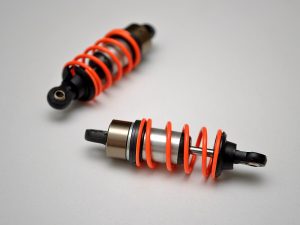Shock absorbers have come a long way since their inception in the early 20th century. What began as simple friction-based mechanisms has evolved into sophisticated adaptive systems that play a vital role in vehicle safety, comfort, and performance. In this article, we’ll trace the development of shock absorbers — from primitive beginnings to advanced electronic dampers — and explain how these innovations impact your driving experience today.
Why Shock Absorbers Matter

Shock absorbers (or dampers) are part of a vehicle’s suspension system. Their primary function is to control spring and suspension movement, ensuring that the tires remain in contact with the road. Without them, a car would bounce uncontrollably after every bump, compromising handling, braking, and ride comfort.
Early Shock Absorbers: Friction and Simplicity
1. Friction Dampers (Pre-1920s)
The earliest shock absorbers were friction-based. These systems used leather or rubber discs compressed together to provide resistance.
| Feature | Details |
|---|---|
| Material | Leather, steel, or rubber pads |
| Resistance mechanism | Friction created by mechanical pressure |
| Drawbacks | Inconsistent performance, high wear rate |
Friction dampers were easy to produce but lacked precision and wore out quickly. Their resistance varied with heat and moisture, making them unreliable in different driving conditions.
Hydraulic Shock Absorbers: The First Major Leap
2. Hydraulic Telescopic Dampers (1930s–1950s)
The introduction of hydraulic fluid significantly improved damping consistency. These shock absorbers used oil to control the movement of a piston inside a sealed cylinder.
| Advantages | Limitations |
|---|---|
| More consistent damping | Heat buildup during prolonged use |
| Greater durability and control | Basic compression and rebound adjustment |
| Improved ride comfort over friction | No active control |
Hydraulic shocks laid the foundation for modern damping systems. They are still widely used today, particularly in budget-friendly vehicles and motorcycles.
Twin-Tube and Monotube Designs: Greater Efficiency
3. Twin-Tube vs. Monotube (1960s–1980s)
These innovations addressed the shortcomings of early hydraulic dampers and introduced new performance levels.
| Type | Structure | Best Use Cases |
|---|---|---|
| Twin-Tube | Inner and outer tubes with piston and oil reservoir | Passenger cars, daily driving |
| Monotube | Single tube with high-pressure gas and floating piston | Performance cars, off-road, racing |
Gas-charged shocks became popular in this era, as they prevented aeration (foaming) of hydraulic fluid, which degraded damping quality.
Electronic and Adjustable Dampers: Intelligence Enters
4. Electronic and Semi-Active Dampers (1990s–2000s)
Vehicle engineers began integrating electronics to provide variable damping based on driving conditions.
Key Features:
-
Sensors read vehicle speed, steering angle, and load
-
ECU adjusts damper force in real time
-
Improves both comfort and cornering stability
| System Type | Description |
|---|---|
| Electronically Controlled Dampers | Adjusts firmness using solenoids or valves |
| Semi-Active Suspension | Changes damping rate without altering ride height |
| Selectable Modes | Comfort, Sport, Off-Road modes on demand |
These systems began appearing in luxury sedans and high-end sports cars, offering drivers enhanced control over vehicle dynamics.
Adaptive and Magnetorheological Dampers: The Future Now
5. Magnetorheological (MR) and Adaptive Dampers (2010s–Present)
The cutting edge of shock absorber technology uses magnetic particles suspended in fluid that change viscosity in milliseconds when exposed to a magnetic field.
Benefits of MR Dampers:
-
Ultra-fast response time
-
Seamless adaptation to road conditions
-
Reduced body roll and enhanced comfort
| Adaptive Feature | Functionality |
|---|---|
| Real-time responsiveness | Adjusts damping 1,000+ times per second |
| Integrated drive modes | Automatically shifts behavior based on selected mode |
| Learning algorithms | AI-based systems adapt to individual driving style |
You can find this tech in vehicles like Audi’s Magnetic Ride, GM’s Magnetic Ride Control, and select BMW and Mercedes-Benz models.
Comparison Table: Shock Absorber Evolution
| Era | Technology | Main Advantage | Typical Vehicles |
|---|---|---|---|
| Pre-1920s | Friction Damper | Simplicity | Early cars, horse-drawn buggies |
| 1930s–1950s | Hydraulic Telescopic | Basic control, durability | All mass-market vehicles |
| 1960s–1980s | Twin-Tube / Monotube | Gas charging, better cooling | Sedans, trucks, performance cars |
| 1990s–2000s | Electronic / Semi-Active | Selective control, safety | Luxury and sports vehicles |
| 2010s–Now | Adaptive / MR Dampers | Real-time tuning, comfort | High-end and performance cars |
Why the Evolution Matters to You

Whether you’re a daily commuter, performance enthusiast, or off-road adventurer, the type of shock absorber on your vehicle impacts:
-
Ride comfort
-
Braking stability
-
Cornering ability
-
Tire lifespan
Choosing the right type — and maintaining it properly — is essential for optimal driving safety and performance.
Where to Get High-Quality Shock Absorbers
Need to upgrade your suspension or replace worn-out shocks? Explore a wide range of reliable products:
This online store offers durable, precision-fit shock absorbers for all types of vehicles — from classic hydraulic units to modern adaptive systems. Use the compatibility tool for fast, accurate selection and enjoy reliable shipping across Europe.
Final Thoughts
Shock absorbers have come a long way from basic friction devices to smart, adaptive systems. This evolution mirrors the automotive industry’s focus on safety, comfort, and performance. Whether you’re driving a 1990s hatchback or a 2020s luxury SUV, your shocks play a pivotal role in how your vehicle behaves.
Understanding this journey not only highlights how far technology has advanced but also helps you make better choices for your vehicle. Ready to experience the difference? Make sure your next set of shock absorbers matches your driving needs and road conditions.